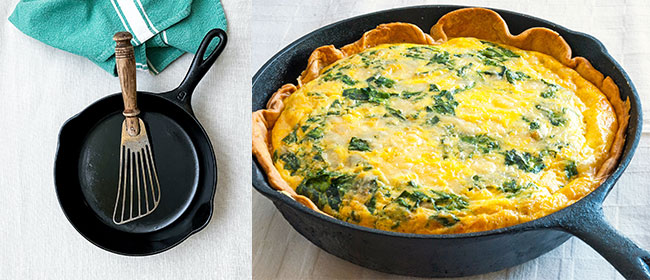Sausage and spinach quiche in a cast iron pan
Cast iron is one of the greatest cookware materials. If cared for properly, your cast iron skillet can last a lifetime. The indestructible, reliable, multi-purpose, affordable, and accessible nature of cast iron cookware makes it a must-have in any modern kitchen. It also offers the added benefit of no toxic ingredients to create a non-stick coating, as is the case with the more modern equivalent: Teflon.
But when it comes to cleaning your cast iron cookware, the sheer number of “don’ts” that you’ll find on the internet can make even the most seasoned cook reluctant to purchase! Don’t use soap, don’t use wool, don’t put it in the dishwasher… These menial instructions make cast iron sound like a nightmare when it comes to cleaning.
We’re here to debunk the myth that cast iron skillets and other cast iron cookware are a pain to clean. In fact, cast iron is one of the easiest materials to clean and care for. And here’s how to do it:
Cleaning
When you’re new to cleaning cast iron, you’re likely to be bombarded by “don’ts” from every angle that make the cleaning process sound incredibly stressful. However, contrary to popular belief, you will not damage your cast iron cookware or the seasoning by using a little soap when required. The secret isn’t that soap will damage the cookware: it’s that it’s not usually necessary.
You will need:
- A sponge or stiff brush
- A clean, dry cloth or paper towels
- Vegetable oil or shortening
- Kosher salt (for tougher food remnants)
How to clean
- Clean your cast iron skillet while it is still warm.
- Remove as much food waste from the skillet as possible and run the water until it’s hot, to not cause thermal shock to the pan.
- Wash your skillet by hand using hot water and a stiff brush or sponge. You should not need to use soap.
- If you have stubborn, burned-on food on the pan, create a paste of kosher salt and hot water to scrub the pan. Use hot water to rinse away the waste.
- Thoroughly dry the skillet with a towel or by putting it on low heat on the stove.
- Use a dry cloth or paper towels to apply a light coat of vegetable oil to top up the cast iron seasoning, then buff to remove any excess oil before storing in a dry location.
You should always wash cast iron cookware by hand, as the dishwasher can damage the enamel and non-stick seasoning coat, and never leave it to soak.
A small amount of soap is absolutely fine to use on your cast iron cookware, but you can still get excellent results without it, and stubborn food remains are easy to remove using kosher salt as a scrubbing agent.
Seasoning
Seasoning is the key to a quality piece of cast iron cookware. This process provides the skillet with a convenient non-stick coating and can even protect the pan from rust and wear.
Many modern cast iron skillets will come pre-seasoned at the factory (like the ones from Uno Casa), but you might still want to top up the seasoning from time to time to ensure the pan stays as top-quality as possible.
You will need:
- Dish soap
- A sponge or stiff brush
- Clean, dry cloths or paper towels
- Vegetable oil or shortening
- Aluminum foil
How to season
- Preheat your oven to 350degF / 180degC and prepare the cast iron skillet by gently washing it with warm, soapy water.
- Rinse all suds off the skillet and dry it thoroughly with a clean, dry cloth or paper towels.
- Pour a little oil onto the skillet and use a clean cloth or paper towel to rub the oil around the whole pan (including the outside and bottom).
- Place the skillet upside-down in the centre of your preheated oven. Place a sheet of foil beneath the pan to catch any drips.
- Bake the skillet for approximately 1 hour, then turn the oven off and allow the pan to cool completely before removing.
- You can repeat this process to create a thicker coat of seasoning on the pan or simply allow the pan to cool and store in a dry location.
The seasoning provides the non-stick layer that gives cast iron cookware such an excellent reputation. Well-seasoned pans will appear dark and smooth and have no oil residue on the surface.
You can check whether your cast iron has been adequately seasoned using the fried egg test. Simply fry an egg on your cast iron skillet with 1 tablespoon of vegetable oil over medium heat.
If the skillet is well-seasoned, the egg shouldn’t stick to the pan or leave any black residue on your cast iron dish.
Final thoughts
As you can see, cleaning your cast iron skillet really isn’t difficult. And with a bit of TLC, you could end up with a piece of cookware that can last generations!
 My Favourites
My Favourites










Speak Your Mind